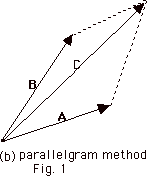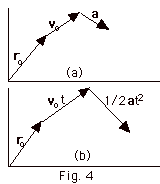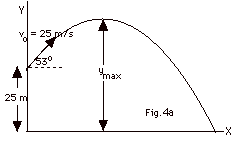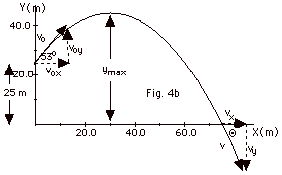|
Outline - Two Dimensional Motion
|
|
- Vector and Scalar Quantities
- Scalar quantity possesses magnitude only. Examples:
speed, mass and temperature. When you state a magnitude
you give a number, e.g. 50 miles/hr
- Vector quantities possess both magnitude and direction.
Examples: displacement, velocity, acceleration, and force.
Magnitude and direction means, for example, 50 miles/hr, south
- Two vectors are equal if they have the same magnitude and
direction. Moving a vector to a different location does
not change the vector as long as its direction and magnitude
remain constant.
- Usefulness of Vectors
- Principle of superposition: If an object is subjected
to two separate influences, each producing a characteristic
type of motion, it responds to each without modifying
its response to the other.
- A vector analysis allows you to separate two-dimensional
motion into two one-dimensional motions and then combine
them at the end of the problem. Example: projectile
motion
- Rules for vector addition
- For vectors along a straight line use a positive sign for
a vector to the right and a negative sign for a vector to
the left.
- For vectors at an angle to each other use:
- The polygon method. In Fig. 1a below, the vectors
are placed head to tail. The resultant vector goes
from the tail of the first vector A to the head
of the second vector B to give C = A
+ B

- The parallelogram method. Draw the vectors with
their tails at one point. Complete the parallelogram
and draw the diagonal to find the resultant. See Fig.
1b below.

- Cartesian coordinates
- Unit vectors. The unit vector i, j,
and k are unit vectors along the X, Y, and Z-axes,
respectively. When multiplied by a number or a symbol
that represents a quantity it becomes a vector with the
magnitude of the quantity (or symbol). For example,
5m i is a vector of length 5 m along the X-axis.
- Components of vectors
- If a vector lies in the X-Y plane, it can be written
as a component in the X-direction added vectorally
to a component in the Y-direction. A = Axi
+ Ayj, where Ax and
Ay are the X and Y components of the vector
A (Fig. 2a below).

- From Fig. 2b above, we see that Ax
= A cos Q Ay
= A sin Q
and A = (Ax2 +
Ay2)1/2
- Utility of components. If two vectors are
equal, their components along any chosen axis are
equal. If C = D, then
Cx = Dx
and Cy = Dy
- Example (Fig. 3 below)

A = Axi + Axj
B = Bxi + Bxj
A + B = (Axi + Ayj)
+ (Bxi + Byj)
=
(Ax + Bx))i + (Ay+
By)j
C = Cxi + Cxj.
If C =A + B, Cx =(Ax
+ Bx)), and
Cy =(Ay+ By)
[Fig. 3 above]
- Sample problems in 107
Problem Set for Two Dimensional Motion: 1-4.
- Constant Acceleration
- For one dimensional motion
- In the X-direction
vx = vox + axt
and
x = xo + vox t + 1/2 axt2
- In the Y-direction
vy = voy + ayt
and
y = yo + voy t + 1/2 ayt2

- For two dimensional motion
v = vo + at
and r = ro + vot
+ 1/2 at2,
where ro = xo i +
yoj, vo = voxi
+ voy j, and a = (axi
+ ayj)
r = xi + yj. From A we
see we may write:
r = (xo + vox t + 1/2 axt2)i
+ (yo + voy t + 1/2 ayt2)j,
or
r = (xoi + yoj)
+ (voxi + voy j)t
+ 1/2(axi + ayj)t2,
or
r = ro
+ vot
+ 1/2 at2
- Motion In Two-Dimensions
- Projectile Motion
- Sample problem. An object is given an initial
velocity of 25 m/s at an angle of 530 with
the horizontal. Find the initial position of the
object along (a) the X-axis, xo, (b)
the Y axis, yo, the initial velocities
along (c) the X-axis, vox, and (d) the
Y-axis, voy. (e) Indicate the directions
of vox and voy on the figure. Find
(f) the maximum vertical height ymax, (g) the
time for object to hit the ground, (h) the distance x
the projectile travels in a horizontal direction, (i)
vx, vy, and v just before the object
hits the ground, and (j) the angle v makes with
the horizontal. Take g = 10 m/s2.

- Approach to solution
- Choose an appropriate X and Y axis. For a
projectile problem, the appropriate X-axis is the
horizontal direction and the Y-axis the vertical direction.
Draw the figure, as shown in Fig. 4b below.

- Set up a chart for the X and Y components of the
descriptive quantities. Identify the quantities asked
for in (a) through (d) of the statement of the problem
along with the components of the acceleration and
enter them in the chart. Then write appropriate formulae
for the components of motion.
|
X
|
Y
|
|
(a) xo = 0
|
(b) yo =25
m
|
|
(c) vox =
25 m/s cos 53o
=15 m/s
|
(d) voy =
25 m/s sin 53o
= 20 m/s
|
|
ax = 0
|
ay = -10 m/s2
|
|
x(t) = xo
+ voxt + 1/2 axt2
|
vy2(y)
= (voy)2 + 2ay(y
- yo)
|
|
(e) x(t) = 0 + 15 m/s
t + 0
|
(f) At ymax,
vy2(y) = 0 =
(20m/s)2- 20m/s2(ymax-25m)
(ymax- 25 m) = 20 m, or
ymax = 45 m
|
| |
(g) y(t) = yo
+ voyt + 1/2 ayt2
when object hits ground,
0 = 25 m + 20 m/s t - 5 m/s2 t2,
or t2-
4 s t - 5 s2 = 0
(t - 5 s)(t +1 s) = 0
t = 5 s. t cannot be negative.
|
|
(h) x(5s) = (15m/s)(5s)
= 75m
|
|
|
(i) vx(t)
= vox + axt
vx(5 s) = vox = 15m/s
|
(i) vy(t)
= voy + ayt
vy(5 s) = 20 m/s -(10 m/s)(5s)
= -30 m/s
|
|
v = (vx2
+ vy2)1/2
= [152 + (-30)2]1/2
m/s = 33.5m/s
|
|
(j) tan Q
= vy/vx = -30/15 = -
2.
Q = - 63o
|
- Sample problems in 107
Problem Set for Two Dimensional Motion: 6-14.
- Uniform Circular Motion
- Definition: A body travelling in a circle with a constant
speed.
In Fig. 6 below, |v| = |v + Dv|
- Instantaneous velocity tangent to the circle at any
instant.
- Displacement vector sweeps through same angle as the
velocity vector.

- Centripetal acceleration
- Look at the triangles of Fig. 6b above.
- Dv/v = Dr/r
or
Dv = vDr/v.
- To find magnitude of acceleration consider:
Dv/Dt
= (v/r)(Dr/Dt)
a = lim Dv/Dt
= (v/r)(v) = v2/r
Dt
 o
o
- Since a = lim of Dv/Dt
as Dt
 0, find the direction of the acceleration by looking at
the direction of Dv
as Dt approaches
0. Dv and
a point into the center of the circle.
0, find the direction of the acceleration by looking at
the direction of Dv
as Dt approaches
0. Dv and
a point into the center of the circle.
- Descriptive Terms
- Period T is the time for one complete revolution
- Frequency f is the number of revolutions per second = 1/T
- The speed of the object = 2pr/T
= 2prf is a CONSTANT.
It's velocity is not constant because it changes direction.
- The magnitude of the acceleration = v2/r
is a constant, but the direction of the acceleration
is not a constant since it continually changes direction.
The direction changes so this is not a case of constant
acceleration and you cannot use the formulas for constant
acceleration.
- Angular velocity w
is the time rate of change of angular displacement =
dQ/dt
- The angle DQ subtends
an arc whose length is Ds.
- By definition, the angle in radians, DQ=
Ds/r.
- Since v = Ds/Dt,
DQ/
Dt = ( Ds/r)/
Dt = v/r. The limit as Dt
approaches zero of DQ/
Dt is w.
So w = v/r.
- The direction of w
is given by the right hand rule: When the fingers
of your right hand are curled in the direction of the
motion, the direction of your thumb points in the direction
of w.
For Fig. 6a above, w
is out of the page.
- While v is not constant for uniform circular
motion, w
is constant.
Q = wt.
- Sample problems in 107
Problem Set for Two Dimensional Motion: 15-18.
|
|